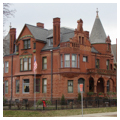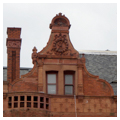The “Red Castle on Wells Street” was built for tobacco merchant George Schuster. His red brick “castle” prefigured the legions of German-style mansions that lined the city’s boulevards and wealthy neighborhoods in the late 1890s. Schuster’s house was also the first of many Northern European–inspired mansions by Crane and Barkhausen. The architects drew on four architectural styles, especially German Renaissance Revival, but all facades are dissimilar. A shingled gable and pedimented window dominates the east side, but on the main facade a shell-like sculpture tops the narrow shaped gable, and related pediments crown the turrets—architectural motifs associated with German buildings. Other notable details include the lion’s-head keystones in the porch arches, red Ohio sandstone cut into rusticated blocks, and orange-red terra-cotta trim.
You are here
George Schuster House
If SAH Archipedia has been useful to you, please consider supporting it.
SAH Archipedia tells the story of the United States through its buildings, landscapes, and cities. This freely available resource empowers the public with authoritative knowledge that deepens their understanding and appreciation of the built environment. But the Society of Architectural Historians, which created SAH Archipedia with University of Virginia Press, needs your support to maintain the high-caliber research, writing, photography, cartography, editing, design, and programming that make SAH Archipedia a trusted online resource available to all who value the history of place, heritage tourism, and learning.











